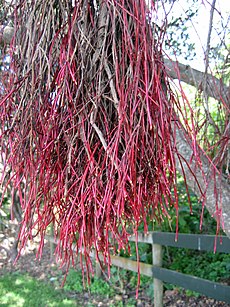
Back Wortel Afrikaans Tapangan AMI Radiz AN جذر Arabic Raigañu (botánica) AST Otapi ATJ Saphi Aymara Kök (orqan) Azerbaijani کوک AZB Wuazn BAR




The roots of a plant is the part that is usually buried in the soil. Roots are usually always under the soil, though–sometimes roots can be above the ground. This is called an aerial root.
Also, stems can sometimes be under the soil (potatoes, for example). Roots do not have leaves, and are different from stems inside.
Plants need their roots especially for three reasons: The roots take water and nutrients, a sort of food, from the soil. They also often store this food. And they fix the plants to the ground.
However, most plant roots do not work at their best unless they have help from fungi. The symbiosis between roots and fungus is known as mycorrhiza.[1]
There are two sorts of root systems:
- the taproot system: there is one very big root that goes down into the ground, and many smaller roots that come out of it
- the diffuse root system: there are many roots that go in all directions
Some roots go very deep into the ground. One root that was found in Arizona, USA, was 60 m below the surface.
Roots are also very strong. Some tree roots can destroy stones. Roots are not green because the cells have no chlorophyll.
- ↑ Brundrett M.C. 2002. Coevolution of roots and mycorrhizas of land plants. New phytologist 154(2): 275-304. DOI | Abstract | Full text (HTML) | Full text (PDF) Archived 2004-11-05 at the Wayback Machine